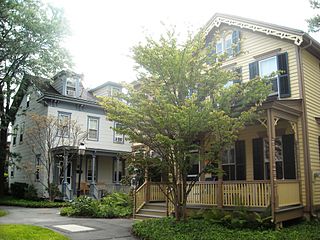
Kingston is an unincorporated community and census designated place (CDP) along the border of South Brunswick Township in Middlesex County and Franklin Township in Somerset County, and also located relatively near Princeton in Mercer County in the U.S. state of New Jersey. The historic settlement is in the Raritan Valley region, located along the course of the Millstone River. As of the 2010 United States Census, the CDP's population was 1,493, of which 1,222 were in South Brunswick Township and 271 in Franklin Township.

John Witherspoon was a Scottish-American Presbyterian minister, educator, farmer, slaveholder, and a Founding Father of the United States. Witherspoon embraced the concepts of Scottish common sense realism, and while president of the College of New Jersey became an influential figure in the development of the United States' national character. Politically active, Witherspoon was a delegate from New Jersey to the Second Continental Congress and a signatory to the July 4, 1776, Declaration of Independence. He was the only active clergyman and the only college president to sign the Declaration. Later, he signed the Articles of Confederation and supported ratification of the Constitution of the United States.

Princeton Theological Seminary (PTSem), officially The Theological Seminary of the Presbyterian Church, is a private school of theology in Princeton, New Jersey. Founded in 1812 under the auspices of Archibald Alexander, the General Assembly of the Presbyterian Church (USA), and the College of New Jersey, it is the second-oldest seminary in the United States. It is also the largest of ten seminaries associated with the Presbyterian Church.

Nassau Hall, colloquially known as Old Nassau, is the oldest building at Princeton University in Princeton, Mercer County, New Jersey, United States. In 1783 it served as the United States Capitol building for four months. At the time it was built in 1756, Nassau Hall was the largest building in colonial New Jersey and the largest academic building in the American colonies.

Princeton Cemetery is located in Princeton, New Jersey, United States. It is owned by the Nassau Presbyterian Church. In his 1878 history of Princeton, New Jersey, John F. Hageman refers to the cemetery as "The Westminster Abbey of the United States."

The Nassau Presbyterian Church is a historic congregation located at 61 Nassau Street in Princeton, New Jersey, United States. It has been the home of many important figures in the history of Presbyterianism in the United States as a result of its proximity to Princeton University and the Princeton Theological Seminary. The church operates the Princeton Cemetery and is a contributing property to the Princeton Historic District. The current pastor is The Reverend Dr. David A. Davis.
West Nottingham Academy is an independent co-ed school serves both boarding and day students in grades 9-12. It was founded in 1744 by the Presbyterian preacher Samuel Finley, who later became President of The College of New Jersey, which is now Princeton University. The 124-acre (0.50 km2), tree-lined campus is in Colora, Maryland near the Chesapeake Bay, an hour south of Philadelphia and 45 minutes north of Baltimore.

The First Presbyterian Church in Chattanooga, Tennessee, located at 554 McCallie Avenue, is a historic, downtown congregation of the Presbyterian Church in America (PCA) and the first Christian congregation founded in Chattanooga.

The Nassau Inn is a full-service hotel in downtown Princeton, New Jersey, United States. It first opened at 52 Nassau Street in 1769 in a home built in 1756. The Inn experienced British occupation during the American Revolution and played host to members of the Continental Congress when it met in nearby Nassau Hall. In 1937, the original inn was demolished to make way for the Palmer Square development and a new, larger, inn opened at 10 Palmer Square in 1938. The hotel's restaurant, the Yankee Doodle Tap Room, has a large mural by Norman Rockwell, depicting Yankee Doodle, behind the bar. It is within walking distance of Princeton University.

First Presbyterian Church of Dallas is a historic congregation at 1835 Young Street in the Farmers Market District of downtown Dallas, Texas (USA). The current building is a contributing property in the Harwood Street Historic District and a Dallas Landmark. The congregation was founded in 1856 as the first U.S. (Southern) Presbyterian Church organized in Dallas, and is the mother church from which many other Presbyterian churches in the area have stemmed.
Princeton University was founded in Elizabeth, New Jersey, in 1746 as the College of New Jersey, shortly before moving into the newly built Nassau Hall in Princeton. In 1783, for about four months Nassau Hall hosted the United States Congress, and many of the students went on to become leaders of the young republic.

The Joseph Henry House is a historic building located on the campus of Princeton University in Princeton, Mercer County, New Jersey, United States. Joseph Henry, a prominent American physicist who worked in electromagnetics, designed the house in 1836 and lived there from its completion in 1838 until taking a position as the first secretary of the Smithsonian Institution in 1848. The construction of the house was offered to the young physicist as part of the University's attempt to hire him away from the Albany Academy in an attempt to raise Princeton's profile. After Henry's departure, the house served as the official housing of the Dean of the College, the University's senior undergraduate academic officer, from 1909 to 1961.

The President's House, also known as the John Maclean House, or simply the Maclean House, in Princeton, Mercer County, New Jersey, United States, was built to serve as the home of the President of the College of New Jersey, which later became Princeton University. It was completed in 1756, the same year as Nassau Hall. United States Founding Father John Witherspoon lived here from 1768 through 1779, during which time he served as a delegate to the Continental Congress and signed the Declaration of Independence. George Washington occupied Maclean House in January 1777, during the Battle of Princeton and in 1783 while Congress met in Nassau Hall.
The Ecumenical Theological Seminary is a private seminary in Detroit, Michigan. Founded in 1980 as the Ecumenical Theological Center, the seminary offers graduate degrees and certificates in religious studies. It is housed in a building built in 1889 to house the First Presbyterian Church; the seminary began leasing the building in 1992 and was donated the building, lands, and endowment in 2002.

Fifth Avenue Presbyterian Church is a Presbyterian Church (U.S.A.) church in New York City. The church, on Fifth Avenue at 7 West 55th Street in Midtown Manhattan, has approximately 2,200 members and is one of the larger PCUSA congregations. The church, founded in 1808 as the Cedar Street Presbyterian Church, has been at this site since 1875.

The First Presbyterian Church of Blissfield is an active church building located at 306 Franklin Street in the village of Blissfield in Blissfield Township in eastern Lenawee County, Michigan. It was designated as a Michigan State Historic Site on June 11, 1965 and was later added to the National Register of Historic Places on September 3, 1971. It was the second property in the county listed on the National Register after the Walker Tavern.
George Hunsinger is an American theologian who is Hazel Thompson McCord Professor of Systematic Theology at Princeton Theological Seminary. He served as director of the Seminary's Center for Karl Barth Studies from 1997 to 2001.

The Princeton Historic District is a 370-acre (150 ha) historic district located in Princeton, New Jersey that was listed on the U.S. National Register of Historic Places in 1975. It stretches from Marquand Park in the west to the Eating Clubs in the East, from the Princeton Cemetery in the north to the Graduate College in the south. The district encompasses the core parts of the campuses of the Princeton Theological Seminary and Princeton University. It also includes the business district centered on Nassau Street and many historic homes, both mansions in the western section and more humble dwellings in the Witherspoon/Jackson neighborhood. Notable churches within the district include Nassau Presbyterian Church, Trinity Episcopal, Nassau Christian Center, and the Princeton University Chapel. The district is home to seven of Princeton's nine, and New Jersey's fifty-eight, National Historic Landmarks, the largest concentration of such sites in the state.

Miller Chapel is the spiritual center of the Princeton Theological Seminary, located in New Jersey, United States, and has been in continuous use since its completion in 1834. It was built by renowned local architect and builder Charles Steadman in stuccoed brick with a simple Doric portico. As the chapel of the oldest Presbyterian Seminary in the United States, the building has been home to many of the most important Presbyterian theologians, including the great figures of the Princeton Theology. The narthex has plaques that honor Samuel Miller, after whom the chapel is named, Charles Hodge, Archibald Alexander Hodge, Caspar Wistar Hodge, Sr., and B. B. Warfield.

Princeton United Methodist Church is a United Methodist congregation located at 7 Vandeventer Avenue in Princeton, New Jersey. The church is located on Nassau Street, directly across from Princeton University.























